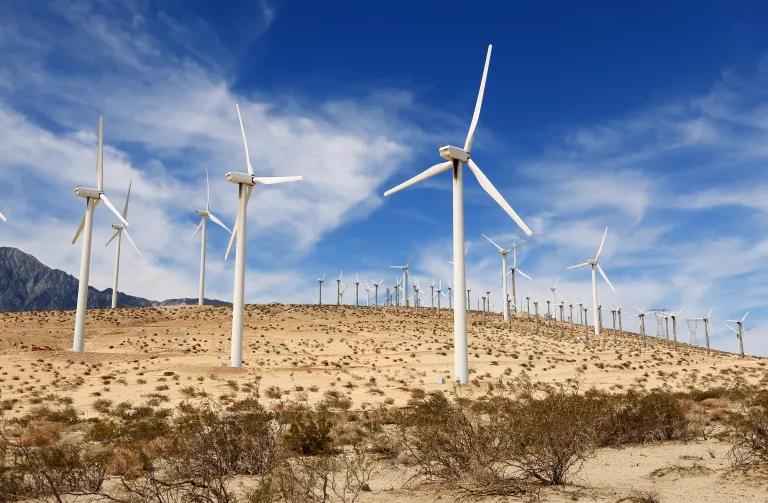Fighting Climate Change in the Age of Trump? Stay Golden, California.
The state knows a thing or two about creating a climate policy that’ll keep battling carbon pollution—even if the feds cut and run.

President-elect Donald Trump has given environmentalists ample cause to worry about the country’s battle against climate change. After calling man-made climate change a Chinese hoax (it’s not), Trump has threatened to reignite the coal industry, ditch the Clean Power Plan, and slip out of the Paris climate agreement. His cabinet appointments also offer little in the way of hope. While none of this is good news, all is not lost. The government still has levelheaded policy makers in its ranks, and a number of states are championing clean energy standards on their own turf. Take a look at California, where climate policies are ahead of the national game.
“When the federal government is not working as hard as we think it should, state policies become all the more essential,” says Cara Horowitz, co–executive director of UCLA Law’s Emmett Institute on Climate Change and the Environment. The state’s climate laws, she asserts, “will remain in place no matter what Trump does.”
In many ways, California’s history of protecting public health and its progressive climate policies go hand in hand. Beset by smoggy skies and rising asthma rates, state government responded with the world’s first vehicle emission regulations in 1966. To compete in California’s market, manufacturers across the country had to churn out cleaner vehicles. According to Dave Clegern of the California Air Resources Board, the regulations were largely responsible for state tailpipe emissions falling nearly 99 percent by 2006. After that, he says, it was just a matter of rejigging car exhaust regulations to combat greenhouse gases. “The tools were already in place,” Clegern says. “We basically just adapted the rules that we already had.”

Later in 2006, then governor Arnold Schwarzenegger signed the nation’s first statewide limit on heat-trapping pollutants, the Global Warming Solutions Act (AB 32). The goal was to return to 1990 emissions levels by 2020, and California is on track to achieve this. In fact, in September 2016, Governor Jerry Brown and the state’s legislative leaders doubled down on the pledge: The Golden State is now committed to seeing its emissions levels fall 40 percent below that target by 2030. Helping Californians meet that goal will be the state’s commitment to doubling energy efficiency in homes, factories, and businesses over the same time frame.
Today, California touts the nation’s only economy-wide emissions-reduction program. This includes landmark policies like the country’s first-ever standards for more energy-efficient computers and a mandatory cap-and-trade system that makes major polluters pay for their carbon emissions.
“As an original cosponsor of AB 32, NRDC is drilling down on policies to produce real carbon pollution reductions,” says Ann Notthoff, NRDC’s California advocacy director. NRDC was among the leading sponsors pushing to put a cap on California’s carbon emissions via clean power plan laws, car regulations, and smart growth and transportation laws.
But strong climate policy isn’t only about cutting pollution. It’s also about finding economical clean energy sources, which California is also doing. The state’s ambitious renewable energy standards require that it get at least half of its electricity from renewable sources by 2030. Analysts feared this shift would do serious damage to the state’s economy. Yet since moving away from fossil fuels, California’s gross domestic product actually rose from $2.19 trillion in 2006 to $2.46 trillion in 2015. Meanwhile, its oil consumption dropped from 330 million to 282 million barrels of crude oil a year between 2006 and 2014, and state employment rose by nearly 8 percent.
As California cuts its electricity and oil consumption, job growth is keeping pace with population growth. Last year, it tied Oregon for the state with the highest economic growth rate.
“This isn’t just a matter of state pride,” Mary Nichols, chair of the California Air Resources Board, told The Mercury News after the election. “We have an economy that is tied to the growth of renewable energy and clean technology…It would be foolish from an economic standpoint to go backward.” So, how might these policies fare in the age of Trump?
“The federal administration can make it more difficult for California to achieve its own goals,” says Horowitz. Under Trump, the government could pull financial support from the U.S. Department of Energy–backed solar operations in the state’s deserts and from the national laboratories busy brewing new renewable tech in California. It could also pass legislation that limits or ends tax credits for electric vehicles or solar and wind power.

But that’s not all. The Trump team has threatened to go after the Endangered Species Act, which could also hurt climate change efforts. The wildlife-saving law helps regulate oil and gas operations on public lands, and the oil industry is quite optimistic that Trump’s pick for interior secretary, Ryan Zinke, will make it easier to drill there.
California is the number three producer of oil in the United States. Even more drilling could be on its way on the millions of federally managed acres inside the state’s borders.
The coast isn’t clear on the state’s coastline either. For years, oil companies have been itching to drill in the waters off Humboldt, Los Angeles, and Orange Counties.
Needless to say, as Trump stocks his cabinet with climate change skeptics and oil and gas industry advocates, California will need to find more allies to help it continue to move forward. “California can’t do this alone,” says Horowitz, and it won’t have to. As in the past, many states have been following California’s environmental lead. Washington, Oregon, and several New England states have adopted similar climate policies. After the election, Illinois passed one of the most significant clean energy bills in decades, Michigan boosted its own renewable energy mandate, and Ohio’s governor vetoed a bill that would have undermined the state’s clean energy goals. Small-scale renewable energy programs are also stronger than they’ve ever been.
The next four years still won’t be easy, and it may never be more important than it is right now to think globally, act locally.
This NRDC.org story is available for online republication by news media outlets or nonprofits under these conditions: The writer(s) must be credited with a byline; you must note prominently that the story was originally published by NRDC.org and link to the original; the story cannot be edited (beyond simple things such as grammar); you can’t resell the story in any form or grant republishing rights to other outlets; you can’t republish our material wholesale or automatically—you need to select stories individually; you can’t republish the photos or graphics on our site without specific permission; you should drop us a note to let us know when you’ve used one of our stories.
California’s Climate Whiplash
Can I Participate in a Class-Action Lawsuit Against Climate Change Inaction?
This Is How We Stand Up to Trump
California’s Climate Whiplash
Can I Participate in a Class-Action Lawsuit Against Climate Change Inaction?
This Is How We Stand Up to Trump
California’s Climate Whiplash
Can I Participate in a Class-Action Lawsuit Against Climate Change Inaction?
This Is How We Stand Up to Trump
California’s Climate Whiplash
Can I Participate in a Class-Action Lawsuit Against Climate Change Inaction?